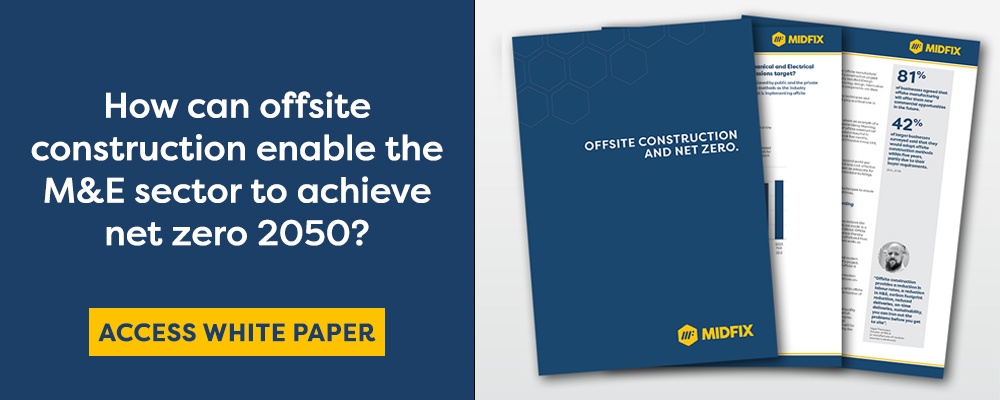Major UK contractors have been adopting off-site construction over the past decade due to cost, health and safety, and sustainability factors. So, what exactly is off-site construction and how can off-site construction help deliver projects on time?
Principal contractors such as Mace, Laing O’ Rourke, and Balfour Beatty are investing in off-site manufacturing for landmark projects. As a manufacturer of pre-fabricated modular supports, we are often asked:
What are the benefits of off-site construction?
The article below helps to answer this question by first defining the topic and then outlining the benefits. By the end of the article, you should be informed and able to make a decision as to whether off-site construction should be planned and detailed at the very start of a project.
What is off-site construction?
“Off-site construction is simply the method of manufacturing and part assembling components away from the live project site” (Design Buildings, 2020). It is often referred to as ‘Prefabrication’ or ‘Modern Methods of Construction’ (MMC) and DfMA. Typically, within off-site construction facilities you will have a highly skilled team of welders and fabricators that will manufacture prefabricated solutions from comprehensive design drawings.
What are the key benefits of off-site construction?
Reduced risk of Health and Safety issues
Pre-fabricating solutions off-site reduces the number of staff on-site minimising the health and safety risk. As the onsite perspective of the construction industry becomes more regulated, certain working practices are inhibited, for example, hot works permits, etc.
Cost efficiencies
Moving site processes into an efficient workshop environment invariably reduces cost. One of the biggest outlays within an M&E installation is labour. With Off-site construction, labour can be kept to a minimum as prefabricated solutions have been fully or partially assembled before they arrive on-site.
Delivering M&E installations on time
When implemented correctly, off-site construction combined with MMC can help M&E contractors complete installations on time. For example, if a factory has produced prefabricated solutions that are fully or part-assembled before they arrive on-site, then they can be quickly installed on-site, thus reducing build times.
When comparing off-site construction to traditional building techniques, it is not heavily influenced by the traditional onsite sign-off hierarchy, as quality management processes are handled off-site to reduce the risk of defects when arriving on-site.
Quality Control
In a controlled factory environment with total quality management procedures in place, errors are reduced, eliminating the traditional challenge where supports built onsite may have to be re-worked due to limited quality control practices.
Positive reduction in carbon footprint
The Net Zero 2050 carbon emissions target came into force in 2019. This immediately put an emphasise on the construction and M&E sector to put into practice environmental and sustainable carbon initiatives. According to the global report, the construction industry contributes to 39% of all carbon emissions. Examples of how off-site construction can help meet the Net-Zero 2050 carbon emissions target are:
- Product waste: eliminates excess offcuts such as channel and studding thus reducing waste.
- Where traditional onsite methods would usually include hot works, off-site facilities have a tendency to utilise sustainable modular solutions as they are a carbon-friendly alternative.
- As off-site is often delivered in part or full assemblies this greatly the amount of packaging waste.
More space on-site.
As solutions are prefabricated off-site there is no need to have cutting and assembly areas on-site. Another key area is the reduced amount of labour and tools onsite. Each of these factors benefits live project sites such as Hospitals, Schools, Prisons, and High-rise residential buildings where space is limited and disruption to other areas of the site needs to be reduced.
Is there a requirement for further British Standards?
The British Standards Institute (BSI) has conducted an in-depth research project on the rise of off-site construction, the report aims to understand the role of standards in this field and the main benefits of introducing them.
The report highlights the following findings:
- The role of the manufacturer is becoming ever more important for off-site construction, as they provide the majority of deliverable assets on-site, such as hot works, into the factory or eliminate them altogether.
- Manufacturers are increasingly addressing design performance in order to deliver the more complex building solutions that they are manufacturing and offering as complete, turnkey solutions.
- There is also an increasing focus on digital manufacturing techniques from other industries (automotive) which are being applied to off-site construction.
(BSI, 2021)
Conclusion
It is now down to the M&E industry and contractors to challenge the status quo. There are clear economic, productivity, and health & safety factors that place off-site construction as a favourable choice over and against traditional onsite construction. The question is, will project stakeholders accept off-site construction as a viable alternative?
REFERENCES
- Global Status Report, 2017, Access: [https://www.worldgbc.org/news-media/WorldGBC-embodied-carbon-report-published#_ftn1]
- Rownload, M (2020); ‘Offsite: how firms are overcoming the barriers’ Access: [https://www.constructionnews.co.uk/tech/offsite-mmc/offsite-how-firms-are-overcoming-the-barriers-21-01-2020/]
- BSI (2021); 'The role of Standards in offsite construction: A review of existing practice and future need' Access: [https://www.bsigroup.com/globalassets/localfiles/en-gb/bsol-construction/offsite-construction-report-web.pdf]



